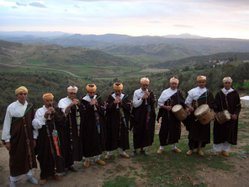Master Musicians ofJoujouka

We are the Master Musicians of Joujouka. We live and continue the traditions of our people in the small village of Joujouka. This is sacred music and can help to heal. MMOJ The Master Musicians of Joujouka are legendary Sufi trance masters from North Morocco. They have been associated with Beat Generation writers Paul Bowles and William Burroughs and the painters Mohammed Hamri and Brion Gysin. Their first album was produced in 1968 by Rolling Stones founder and lead guitarist Brian Jones and is commonly regarded as the first "World Music" album. The Master Musicians have collaborated, performed and recorded with artists as diverse as Ornette Coleman, Marianne Faithfull, Scanner, Lee Renaldo and Bill Laswell. The musicians prefer to live and play near the sanctuary of their saint, Sidi Achmed Shiech, and rarely perform outside Morocco. Joujouka is a small village in the Al Sheriff mountains in Northern Morocco. For centuries the main occupation of the men of the village was playing music. The best Joujouka musicians traditionally played at the court of the Moroccan sultans. Joujouka is renowned for Sufi trance music, which utilises the technique of circular breathing backed by trance-inducing rhythms. The traditional instruments in Joujouka are the rhaita (an oboe-like double reed instrument), reed flutes and small drums. The two sided drums use sheep hide for skins. The special rhythms of Joujouka combine with the simple melodies of the pipes, or flutes, to create an orchestral sound. Song is also at the core of the music in the village. There are many songs which deal with folk themes and mountain life. The subjects are as varied as in any folk music and include songs about love and beautiful girls; "Saudia Djibilia" (Saudia the mountain girl), and "Sharbuni a Thè" (Your eyes make me want to drink tea), as well as failed marriages and the abuse of marijuana, "El Hashish Umlata" (Hashish too Much). The beauty of the mountains is praised in the songs like Abaldi a Bin Hassan (My Country the Mountain Hassan) and "Joujouka Ei Calihoun" (Joujouka Black Eyes). Boujeloudia The instrumental music in Joujouka forms two distinct repertoires with very different origins. Firstly there is the music called Boujeloudia which is traditionally performed annually on the Islamic feast of Aid el Kebir. This suite of music is played while a boy sewn into fresh goat skins dances in frenzy. The music is used to keep the goat-man at bay. The music for Boujeloud, or the Father of Skins, is frantic and has six movements which would equate to a symphony or the score of an opera if it were European classical music. The festival and ritual originate in the worship of the God Pan. Pan was evoked in the springtime to ensure the fertility of both the crops and the people. The people of Joujouka have kept this ancient tradition alive. Sidi Achmed Sheich was an Islamic missionary who is known as "The Cultivator with Lions and the Healer of Crazy Minds". His tomb in Joujouka has for a thousand years been visited by people wanting cures for emotional ailments and other health problems. The saint felt that because the musicians in Joujouka used a special breathing technique, breathing in and out simultaneously, their music could be harnessed to heal the sick. Before a mosque was built in Joujouka the musicians traditionally met on Friday mornings in the sanctuary of Sidi Achmed Sheich to play this healing music beside his tomb. The music has a strange and haunting sound and can have a profound effect on the listener. The musical skill needed to play it correctly and imbue it with its healing qualities is only achieved by mature musicians who revere their saint and who have become true Master Musicians. It is this music and the spirituality that surrounds it that sets the Master Musicians of Joujouka apart from other musicians in North Morocco. This Sufi tradition is a vital part of the life of the musicians and those who stray from it are no longer welcome in the brotherhood.

1 Comments:
vi um concerto desta banda no festival d sines de ha dois anos atrás.
mas o som era um bocado repetitivo, apesar d agradável. e eu estava "way beyond"...
Enviar um comentário
<< Home